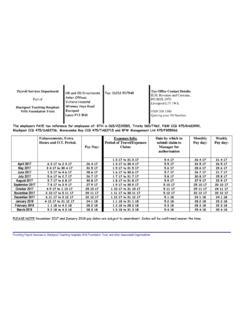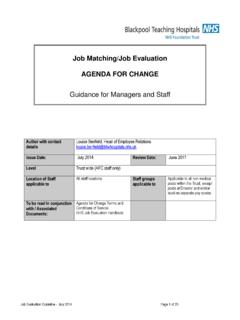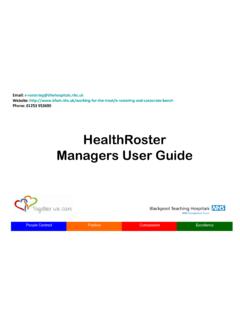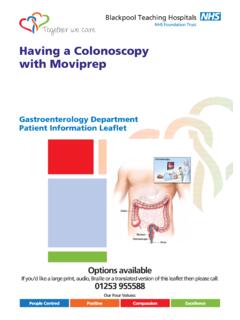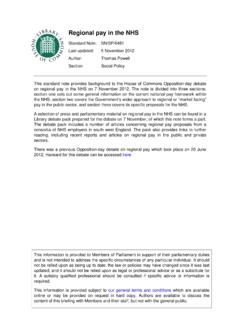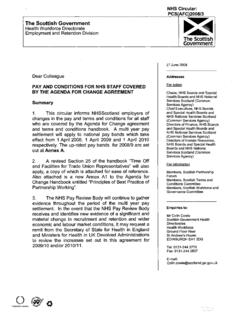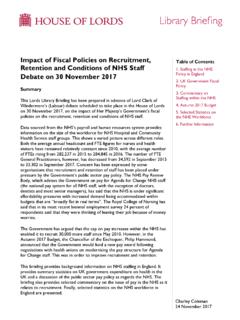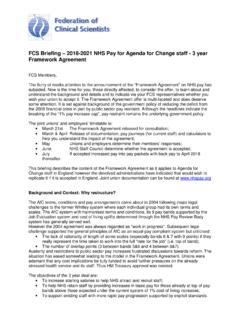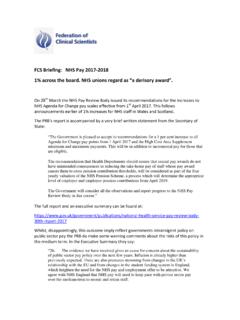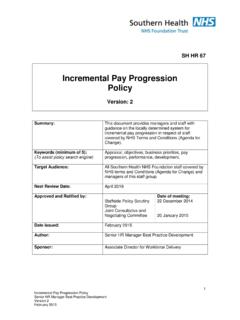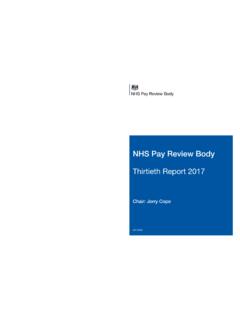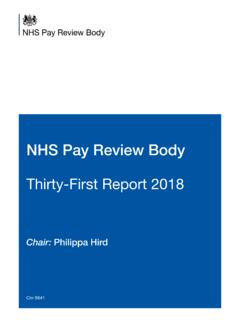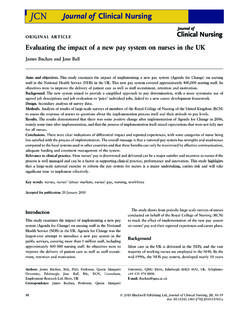Transcription of Extract from NHS Employers Website: Key Changes and Q&A’s
1 1 Extract from NHS Employers Website: Key Changes and Q&A s Band 1 - 3 Key Changes include: Band 1 to be closed to new entrants from the 01 December 2018. Upskilling of current band 1 roles to band 2 roles to be completed by 31 March 2021. Those unable or unwilling to move into new band 2 roles to be able to remain in their current band 1 role. Band 1 to become a single spot salary. Band 2 and band 3 will have two step points and take a minimum of two years to progress to the top of their band. The minimum pay rate for the NHS will be above the Living Wage Foundation living wage rate as of November 2017. Those existing staff earning 18,160 or less to retain their unsocial hours payments whilst off sick.
2 For the next three years the unsocial hours percentage rates will be adjusted to reflect the increase in basic salary, while preserving the value of the current payment tiers. Bands 4 7 Key Changes include: Shorter periods to progress to the top of the pay band: o Band 4 will have two step points and take a minimum of three years to progress to the top of the band. o Band 5 will have three step points, taking a minimum of two years to progress from the entry step point to the mid step point and then a further minimum of two years to progress to the top of the band. o Band 6 and band 7 will have three step points, taking a minimum of two years to progress from the entry step point to the mid step point and then a further minimum of three years to progress to the top of the band.
3 No specific Changes to the terms and conditions for Bands 4 to 7. 2 Bands 8a 9 Key Changes include: Bands 8 and band 9 will have two step points taking a minimum of five years to progress from the entry step point to the top of the band. For Band 8C, 8D and Band 9, the top step point will have a 5 to 10 per cent of their basic salary annually re-earnable, subject to meeting performance requirements. Those staff with reserved rights from the NHS Terms and Conditions 2013 (NHS TCS 2013) Changes will continue to receive protection on a marked time basis. Pay increase for those on Band 8D and Band 9 will be capped at the increase for those on the top step point in Band 8C. Pay progression 08/06/2018 11:56:00 The agreement contains a new pay progression framework, endorsed by the NHS Staff Council, which will be effective from 1 April 2019.
4 The new pay progression system will ensure that all staff receive the help and support needed to gain the appropriate knowledge and skills they need to carry out their roles. The new system will have a simple process to strengthen appraisal systems. Employers will be better placed to identify ways to improve patient care through staff learning and development, across their workforce. Effective use of appraisals will enable trusts to identify those staff that would benefit from further development opportunities. This will help to create a culture based upon continuous learning which in turn will help improve the patient experience. The new pay progression system will: enable staff in bands 2 to 7 to reach the top of their pay band more quickly describe expected minimum periods of time before progression to the next pay-step point 3 give staff the opportunity to demonstrate they have met the required standards, putting annual appraisals and continuous professional development at the centre of the process require line managers and staff to follow the pay-step submission process in order to access the next pay-step point (refer to the detail on pay progression as set out in the Annex B of the main Framework Agreement)
5 Require Employers to provide information to enable the NHS Staff Council to undertake regular monitoring of pay progression and re-earnable pay as well as information pertaining to employees with protected characteristics not be automatic, pay step points will be closed within ESR (the payroll system). It is expected that staff who meet the required standards by their pay step date will progress to their next pay step point. The key points of the required standards for pay progression are detailed below: a completed individual appraisal process that is in line with the organisation s standards no live formal disciplinary action on the staff members record all statutory and/or mandatory training is fully complete any local standards, as agreed through partnership working have been met for line managers only all appraisals for their staff must be complete.
6 Further information relating to the pay progression framework can be found in the framework agreement document at Annex B. 4 Q&A s 15/06/2018 12:30 1. About the 2018 contract How did we get here and why was a deal negotiated? Agenda for Change was introduced in 2004 which brought together several pay arrangements in to one overall pay structure underpinned by Job Evaluation. While its success is well recognised, the NHS Trade Unions and Employers agreed the need for change to modernise Agenda for Change in a number of areas. The agreement reached in 2013 was recognised by all parties as the start of a wider conversation on the refresh of Agenda for Change. During the Autumn Budget (22 November 2017), the Chancellor of the Exchequer confirmed negotiations had commenced on the reform of Agenda for Change pay, terms and conditions framework.
7 The Chancellor confirmed a commitment to provide additional funding for the lifting of the pay cap for the NHS Agenda for Change staff providing negotiations reached satisfactory conclusions, where funding would only be provided in return for increases to productivity, recruitment and retention. Will ESR be ready for implementation of the Changes to pay and terms and conditions in 2018? We are working with colleagues from ESR to ensure that the system will be prepared and ready to support the Changes to pay, terms and conditions as part of any implemented deal. ESR have assured us that the system will be ready to pay staff the new pay rates in July. What is the breakdown of funding? Presumably some level of pay award was already budgeted for?
8 The government had already budgeted, as part of the 2015 spending round, for average pay increases of 1 per cent from 2016/2017 to 2019/2020. The is additional funding on top of what had already been budgeted for in the system. The additional funding will pay for the reform of the pay structure (which includes higher starting salaries and faster progression to the top of each pay band for most staff), as well as the consolidated annual pay increases to the top of bands over the three years, and including the non-consolidated payment that will be made to staff at the top of band in 2019/20. How will the funding work? 5 The Department of Health and Social Care has confirmed that the multi-year deal is fully funded and that work continues on the best mechanism for ensuring NHS organisations and eligible non-NHS organisations receive the additional funding.
9 What will happen at the end of the three year period? The pay award for 2021/2022 will be for government to decide as part of its agreed budget for public sector pay. The NHS Pay review body will retain its standing remit. Are Scotland, Wales and Northern Ireland going to have the same deal? The deal at the moment is for England only. The Barnett formula means any additional funding will also have to be provided to the devolved administrations. It is up to these administrations to determine what they do with this money, they are free to negotiate a deal with their trade unions which mirrors what has been negotiated for England. What is happening to employee NHS pension contributions? The deal is about contract reform and annual pay awards only.
10 The agreement did not consider Changes to pension contributions. A review of employee contributions is currently taking place alongside the scheme valuation exercise and any Changes to the contribution rates will be implemented from 1 April 2019. The current contribution rates and tier thresholds are fixed in the NHS Pension Scheme regulations until 31 March 2019. The scheme has a tiered contribution structure where employee contribution rates are based on the member s whole time equivalent pensionable pay. Employers should re-assess the tiered contribution rate for their employees based on the 2018/19 pay increase and apply a new contribution rate if this is appropriate. As employee contributions are assessed on pensionable pay, which includes additional and variable payments and salary sacrifice deductions, the impact may be different for each individual.

